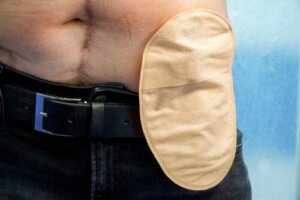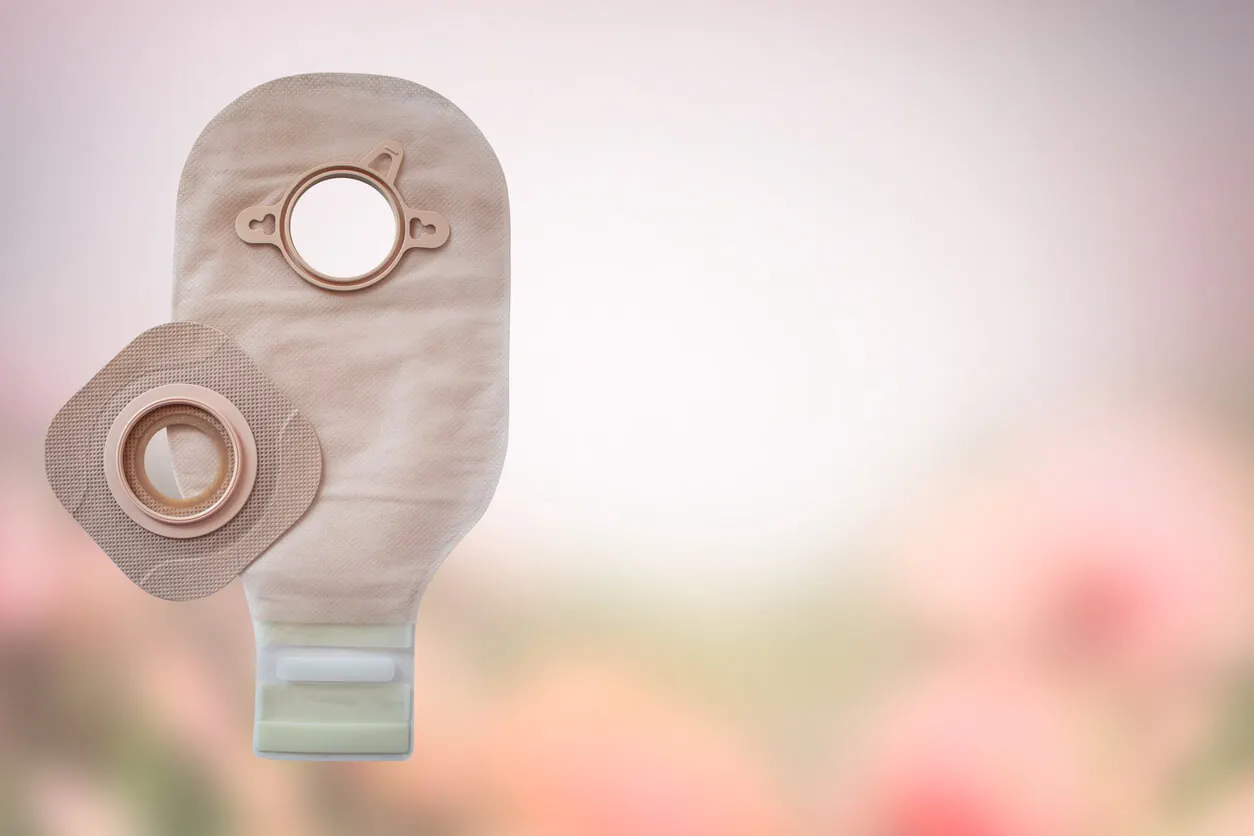Tips for Day-to-Day Life After an Ostomy


Reviewed and approved by the nurse Leidy Mora Molina
An ostomy is surgical treatment that facilitates the evacuation of waste products from the body, such as feces and urine, carried out on a certain group of people. Colorectal cancer, Crohn’s disease and ulcerative colitis are some of the diseases that condition its performance. We’ll tell you some tips for the your day-to-day life after an ostomy.
At present, studies estimate that around 100,000 people have an ostomy in the United States every year. The quality of life and long-term prognosis depend on each person’s ability to adapt and their instruction in daily care.
What’s an ostomy?
There’s a small group of gastrointestinal and urological conditions where the structure of certain organs needs to be modified for therapeutic purposes. The ostomy is a surgical intervention that allows the creation of an artificial opening or stoma, from the intestine to the abdominal wall, facilitating the elimination of feces or urine through this route.
In general, the stoma isn’t able to act as a natural sphincter, as it doesn’t have the appropriate musculature. Therefore, the ostomate cannot control the outflow of waste products. In this sense, it’s necessary to connect a piece of equipment or bag on the outside that will act as a collection system.
Types of ostomy and when they’re performed
Digestive ostomies include colostomy, cecostomy, and ileostomy. Each one is applied in specific cases, depending on the disease and the general condition of the person to be operated on. In addition, they can be performed on a temporary or permanent basis.
Colostomy
It creates a communication between the colon and the skin of the abdomen to decompress the large intestine and redirect the stools. It can be ascending, transverse, descending, or sigmoid, depending on the segment of the colon where it’s fitted.
Obstruction of the large bowel is the most common cause of needing a colostomy. Some of the associated diseases include the following:
- Diverticular disease
- Crohn’s disease
- Ulcerative colitis
- Colonic stenosis
- Colorectal cancer
Cecostomy
This is a rare type of ostomy in which the cecum is connected to the abdominal wall. It’s usually performed in cases of bowel decompression emergencies. Cecal volvulus and pseudo-obstruction of the colon are some of the conditions that can be resolved by this method.
Ileostomy
This is the opening of the distal ileum to the skin of the abdomen. This type of ostomy is more delicate, due to the liquid and proteolytic characteristics of the contents of the ileum, which sometimes tends to damage the abdominal skin. Some of the cases in which an ostomy is necessary include ulcerative colitis and familial polyposis.
Read more: What’s a Colostomy?
9 tips for day-to-day life after an ostomy
Some tips can significantly improve the quality of life of the person with an ostomy. It isn’t always easy to apply them, but they can guide you so that the procedure isn’t a complete impediment to daily activities.
1. Adapt social and work life
At the end of the ostomy and the post-surgical recovery period, it’s essential to resume social and family activities with some small changes in lifestyle. In general, you’ll be able to do most of the activities you did before the operation.
When you leave home, don’t forget to take with you everything you need for the ostomy pouch replacement. Likewise, keep a change of clothes in case of any unforeseen event.
Work life should be resumed gradually. High-intensity manual labor and heavy lifting are usually contraindicated. A tip when returning to work after an ostomy is to ensure quick access to the restroom or a private area for pouch changing.

2. Wear appropriate clothing
In most cases, ostomates can continue to wear their usual clothing. However, a crucial tip after an ostomy is to avoid tight-fitting garments or those that may compress the stoma excessively. In addition, suspenders or elastics can be used to replace the belt.
3. Resume sports progressively
Post-ostomy physical activity should be resumed as soon as possible, starting with light-intensity exercise. In the long term, people can continue to practice any sport they practiced before the intervention, with the exception of those with high impact, sudden movements, or weight lifting.
In general, current ostomy systems don’t come off with movement and sweat. Consult with a medical specialist before resuming sports though.
Some recommendations to keep in mind when performing physical activities are the following:
- Verify that the ostomy pouch is adhered to the skin and change it if necessary
- Cover the device filter with special stickers if you plan to do water sports
- Avoid sticking the device minutes before immersing in water
- Empty the device before starting exercise
- Maintain adequate hydration
4. Sexual re-education
Sexual relations can continue as normal after the procedure. However, a crucial post-ostomy tip is to work on self-esteem, sexual re-education, and acceptance.
Research states that the impact of an ostomy is devastating for patients, even in an uncomplicated postoperative period. How the patient adjusts to an altered body image impacts their ability to establish personal relationships, experience and express their sexuality, and go through the rehabilitation process.
Some women may experience problems and discomfort during intercourse, while men may experience erectile dysfunction. It is important to talk to the partner and look for alternatives.
Women should see a gynecologist in case of vaginal dryness.
5. Take precautions when traveling and driving
Adequate preparation when away from home is key in daily care after an ostomy. In this sense, it’s recommended to carry a case with several changes of clothes and bag replacements when traveling by plane. In this way, you’ll be able to take care of any unforeseen event that may arise during the flight.
As regards returning to the road, it will be necessary to wait at least 6 weeks after the ostomy to resume driving. In addition, a road safety system for pregnant women can be used in case the seat belt is uncomfortable.
6. Protect the skin around the stoma
Occasionally, waste excreted through the stoma can cause hypersensitivity and discomfort to the surrounding skin. In this regard, the following care measures are recommended:
- Change the ostomy pouch periodically to prevent leakage
- Use an appropriately sized pouch and skin barrier opening
- Remove collection equipment carefully and avoid removing it more than necessary
- Seek medical help in case of an allergy to adhesive material or ostomy equipment
- Clean the skin around the stoma with water and dry thoroughly before installing the skin barrier and collection bag
You may be interested in reading: Symptoms of Colon Cancer in Women
7. Maintain proper hygiene
It’s common for people to fear bathing, concerned about the effect that water or soap may have on the stoma. However, this worry can be eased, as the equipment is able to withstand showers without any problems.
Sometimes soap may interfere with skin barrier adhesion, so one may choose to wash the surrounding area with water only. Another option is to wash the area with plenty of water after applying the soap. It isn’t recommended to remove the collection bag when showering or taking a bath.

8. Learn how to empty and replace the pouch correctly
After surgery, the medical center staff will instruct you on how to properly empty and replace the collection system. It isn’t necessary to use sterile materials to clean the area during the exchange.
A practical tip is to empty the ostomy pouch when it reaches one-half to one-third of its capacity, thus avoiding leaks or spills. The steps for emptying the collection bag are as follows:
- Sit in a chair in front of or on the toilet, as far back as possible.
- Cover the toilet with toilet paper to reduce splashing.
- With one hand, hold the collection bag up; with the other hand, open the fastener.
- Lean over the toilet and slowly open the bag.
- Empty the contents of the bag gradually.
- Clean the inner and outer end of the bag with toilet paper.
- Reattach the pouch and place the fastener.
9. Avoid excessive hair growth
Hair in the stoma area can affect the adhesion and fixation of the skin barrier. Likewise, it could also cause discomfort and pain when removing it. In this sense, it is advisable to shave or trim the hair in the area with scissors.
Care should be taken when shaving the area. It’s advisable to use a stoma powder after shaving, as soap and shaving creams can also affect the fixation of the device.
Don’t forget to rinse with plenty of water and dry the area before repositioning the pouch.
Prompt medical attention is essential
There are several useful tips for care after an ostomy. These are intended to improve the person’s quality of life and avoid long-term complications.
Similarly, seeking medical attention shouldn’t be delayed if unusual symptoms occur. The collection system should be checked at the slightest doubt about its correct functioning.
All cited sources were thoroughly reviewed by our team to ensure their quality, reliability, currency, and validity. The bibliography of this article was considered reliable and of academic or scientific accuracy.
- Gómez A. El paciente ostomizado. Farmacia Profesional. 2006; 20(8): 50-55.
- Noda Sardiñas C, Alfonso Alfonso L, Fonte Sosa M, Valentín Arbona F, et al. Problemática actual del paciente con ostomía. Rev Cub Med Mil. 2001; 30( 4 ): 256-262.
- Folguera-Arnau M, Gutiérrez-Vilaplana JM, González-María E, Moreno-Casbas MT, et al. Implementation of best practice guidelines for ostomy care and management: Care outcomes. Enferm Clin (Engl Ed). 2020 May-Jun;30(3):176-184.
- Yang M, McClure JA, Wanis KN, Vogt KN, et al. From Formation to Closure: Aggregate Morbidity and Mortality Associated With Defunctioning Loop Ileostomies. Dis Colon Rectum. 2022 Sep 1;65(9):1135-1142.
- De La Llera Domínguez Gerardo. Colostomías: clasificación, indicaciones, detalles de técnica. Rev Cubana Cir. 2007; 46( 4 ).
This text is provided for informational purposes only and does not replace consultation with a professional. If in doubt, consult your specialist.








